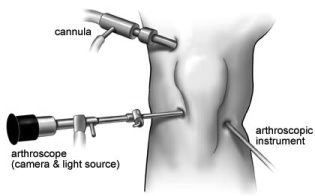Knee arthroscopy is a technique used to inspect the inside of the joint cavity to diagnose and assess damage and, where possible, to treat this damage. Arthroscopic knee surgery involves a small telescope, video equipment and instruments. Arthroscopic knee surgery is used to treat any number of conditions that occur within the knee from simple cartilage tears to removal of loose bodies and anterior cruciate ligament reconstruction. At the same time all of the other structures within the knee can be clearly viewed and probed.

Arthroscopic knee surgery requires a hospital operating theatre and is usually performed as day case surgery. arthroscopic knee operation is normally done under a general anaesthetic but may be done under epidural, spinal or occasionally a local anaesthetic if necessary. Typically the patient might come into hospital shortly before the arthroscopic knee operation having been pre-assessed as fit for surgery.
The arthroscopic knee operation requires two or three small incisions in the knee joint to allow insertion of fluid, the arthroscope [attached to a camera] and instruments. The length of these incisions is approximately 5-7 mm. Occasionally an incision will have to be enlarged in order to remove a fragment from the knee.The length of time the arthroscopic knee surgery takes depends on the procedure which is being performed. Simple arthroscopic knee surgery (i.e. excluding more complicated arthroscopic procedures such as arthroscopic ACL reconstruction) usually takes between 10 and 30 minutes.
Following the arthroscopic knee surgery, a local anaesthetic solution is normally injected into the joint to assist with pain relief.The small incisions rarely require stitches, and will usually have a simple dressing applied with a bandage wrapped around the knee.Once the patient has recovered from the anaesthetic and started to mobilise, they are normally safe to be discharged from hospital.Typically this may be two hours after arthroscopic knee surgery but some patients take longer to recover.It is essential that the patient has somebody else to drive them home. The patient should undertake essential walking only for the first two to three days.
For the first couple of days, the leg should be rested and elevated as much as possible. Simple painkillers and cold packs may be used as required.
The large bandage around the knee is normally removed 24-48 hours after arthroscopic knee surgery. There are usually no stitches to be removed and the wounds should be kept clean and dry until they have completely healed. A small dressing or plaster can be placed on these wounds for a few days following arthroscopic knee surgery.
In the first few days following arthroscopic knee surgery, simple rehabilitation exercises including straight leg raising, knee and ankle movements and tensioning of the quadriceps [thigh] muscles should be undertaken as recommended by your Surgeon/Physiotherapist.
Physiotherapy: Some patients require physiotherapy following arthroscopic knee surgery. This may take place either before or after the first post-operative check-up depending on individual need.
Generally, a return to activities takes between two and six weeks following arthroscopic knee surgery. Recovery, however, depends on the extent of damage found within the knee, the treatment performed, the type of activities to which the patient wishes to return and the general fitness of the patient. Approximate recovery times following simple arthroscopic surgery are:-
The small wounds can remain tender and thickened for a few weeks following arthroscopic knee surgery. Occasionally, a lump remains under one or other of the puncture holes for several weeks – this will slowly resolve.
Knee arthroscopy is not itself damaging to the knee joint. Any ongoing symptoms following arthroscopic knee surgery are usually the result of the problem within the knee joint for which the surgery was recommended and not as a result of the arthroscopy itself.
Arthroscopy has a very low complication rate. However, complications such as infection, excessive swelling and pain can occur along with rare general complications such as blood clots and anaesthetic risks. In general, the risk of major problems is much less than 1%.